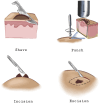Mini review on skin biopsy: traditional and modern techniques
- PMID: 40109731
- PMCID: PMC11919677
- DOI: 10.3389/fmed.2025.1476685
Mini review on skin biopsy: traditional and modern techniques
Abstract
The incidence of skin cancer continues to rise due to increased sun exposure and tanning habits, requiring early detection and treatment for favorable outcomes. Skin biopsy is an important diagnostic tool in dermatology and pathology, as it provides a valuable understanding of various skin diseases. Proper handling of skin biopsy specimens is vital to ensure accurate histopathological assessment. Still, the use of light microscopy and immunofluorescence provides a comprehensive approach to evaluating skin biopsy specimens, with each contributing unique information to aid in accurate diagnosis and management. This review highlights the evolution of skin biopsy practices, from traditional techniques to advanced methods incorporating artificial intelligence (AI) and convolutional neural networks. AI technologies enhance diagnostic accuracy and efficiency, aiding in the rapid analysis of skin lesions and biopsies. Despite challenges such as the need for extensively annotated datasets and ethical considerations, AI shows promise in dermatological diagnostics. The future of skin biopsy lies in minimally invasive techniques, liquid biopsies, and integrated pharmacogenomics for personalized medicine.
Keywords: artificial intelligence; convolutional neural networks; immunofluorescence; light microscopy; skin biopsy.
Copyright © 2025 Alwahaibi and Alwahaibi.
Conflict of interest statement
The authors declare that the research was conducted in the absence of any commercial or financial relationships that could be construed as a potential conflict of interest.
Figures
Similar articles
-
AI in dermatology: a comprehensive review into skin cancer detection.PeerJ Comput Sci. 2024 Dec 5;10:e2530. doi: 10.7717/peerj-cs.2530. eCollection 2024. PeerJ Comput Sci. 2024. PMID: 39896358 Free PMC article.
-
The Role of Artificial Intelligence in the Diagnosis of Melanoma.Cureus. 2024 Sep 20;16(9):e69818. doi: 10.7759/cureus.69818. eCollection 2024 Sep. Cureus. 2024. PMID: 39308840 Free PMC article. Review.
-
Artificial Intelligence (AI) and Liquid Biopsy Transforming Early Detection of Liver Metastases in Gastrointestinal Cancers.Curr Cancer Drug Targets. 2025 Jan 21. doi: 10.2174/0115680096331238241125051307. Online ahead of print. Curr Cancer Drug Targets. 2025. PMID: 39844562
-
Outlier detection in dermatology: Performance of different convolutional neural networks for binary classification of inflammatory skin diseases.J Eur Acad Dermatol Venereol. 2023 May;37(5):1071-1079. doi: 10.1111/jdv.18853. Epub 2023 Jan 27. J Eur Acad Dermatol Venereol. 2023. PMID: 36606561
-
Role of In Vivo Reflectance Confocal Microscopy in the Analysis of Melanocytic Lesions.Acta Dermatovenerol Croat. 2018 Apr;26(1):64-67. Acta Dermatovenerol Croat. 2018. PMID: 29782304 Review.
References
Publication types
LinkOut - more resources
Full Text Sources


